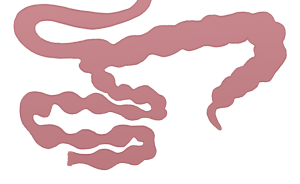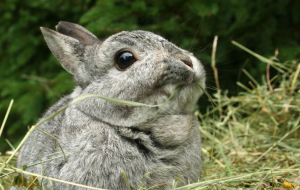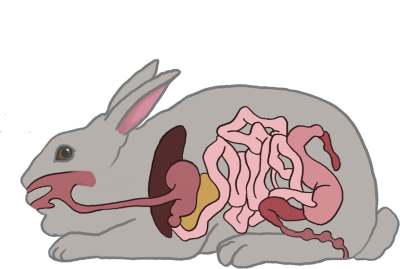5 The Cecum! A Big Fermentation Vat! (Feat. The Rest of the Large Intestine)
The Cecum & The Rest of the Large Intestine

 Herbivores, animals that only eat vegetation, cannot digest fiber on their own. These animals have evolved ways to “employ” microbes (microscopic organisms like protozoa, bacteria, and yeast) in their digestive tract to eat the fiber for them! The byproducts from these microbes provide much needed vitamins, fatty acids and proteins to keep their bodies functioning! It is a process called fermentation. Some animals, like the cow, use a compartment in their stomach called the rumen to store microbes. Rabbits, on the other hand, store their microbes in the cecum. Because the cecum is near the back end
Herbivores, animals that only eat vegetation, cannot digest fiber on their own. These animals have evolved ways to “employ” microbes (microscopic organisms like protozoa, bacteria, and yeast) in their digestive tract to eat the fiber for them! The byproducts from these microbes provide much needed vitamins, fatty acids and proteins to keep their bodies functioning! It is a process called fermentation. Some animals, like the cow, use a compartment in their stomach called the rumen to store microbes. Rabbits, on the other hand, store their microbes in the cecum. Because the cecum is near the back end
 of the digestive tract, rabbits are what we call “hindgut fermenters.” After the digesta leaves the ileum of the small intestine, it splits into two paths depending on the size of the food particles. Long fibers move on through the cecum and then out the proximal and distal large intestine to be processed into fecal pellets. The shorter bits of fiber leave the cecum with the long fibers, but then move back up the proximal large intestine to be fermented by the microbes in the cecum. The cecal wall forms a spiral with 22-25 coils, thus increasing the mucosal surface area in contact with the cecal content. Some of these nutrients are absorbed directly into the wall of the cecum. After approximately 8 hours in the cecum, the digesta that wasn’t able to be absorbed through the cecal wall is pooped out in the form of cecotropes, which the bunny will eat after it leaves the rectum and anus to be digested a second time around. This is an important part of bunny digestion–it allows the rabbit to get the most out of their plant-based diet!
of the digestive tract, rabbits are what we call “hindgut fermenters.” After the digesta leaves the ileum of the small intestine, it splits into two paths depending on the size of the food particles. Long fibers move on through the cecum and then out the proximal and distal large intestine to be processed into fecal pellets. The shorter bits of fiber leave the cecum with the long fibers, but then move back up the proximal large intestine to be fermented by the microbes in the cecum. The cecal wall forms a spiral with 22-25 coils, thus increasing the mucosal surface area in contact with the cecal content. Some of these nutrients are absorbed directly into the wall of the cecum. After approximately 8 hours in the cecum, the digesta that wasn’t able to be absorbed through the cecal wall is pooped out in the form of cecotropes, which the bunny will eat after it leaves the rectum and anus to be digested a second time around. This is an important part of bunny digestion–it allows the rabbit to get the most out of their plant-based diet!
